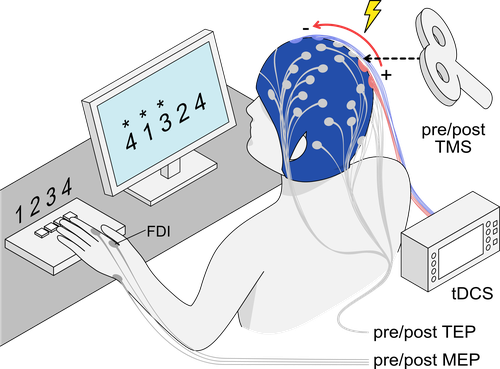
Increasing stimulation intensity does not affect motor learning
 based on reviews by 1 anonymous reviewer
based on reviews by 1 anonymous reviewer

Dose-response of tDCS effects on motor learning and cortical excitability: a preregistered study
Abstract
Recommendation: posted 30 October 2024, validated 08 November 2024
Artemenko, C. (2024) Increasing stimulation intensity does not affect motor learning. Peer Community in Registered Reports, 100891. 10.24072/pci.rr.100891
This is a stage 2 based on:
Gavin Hsu, Dylan J. Edwards, Leonardo G. Cohen, Lucas C. Parra
https://osf.io/k6abp
Recommendation
Level of bias control achieved: Level 2. At least some data/evidence that was used to answer the research question had been accessed and partially observed by the authors prior to Stage 1 in-principle acceptance, but the authors certify that they had not yet observed the key variables within the data that were used to answer the research question.
List of eligible PCI RR-friendly journals:
The recommender in charge of the evaluation of the article and the reviewers declared that they have no conflict of interest (as defined in the code of conduct of PCI) with the authors or with the content of the article.
Evaluation round #1
DOI or URL of the report: https://osf.io/kxrdb
Version of the report: 2.0
Author's Reply, 25 Oct 2024
Dear Dr. Artemenko,
Here we submit the latest version of our Stage 2 manuscript with the requested minor revisions. Please note that we made a correction to the statistics for one of our exploratory analyses (correlation between performance and sensation) that was wrong due to a previous mistake in the analysis code. We also added a statement about how EEG may have affected the results (under "Comparison to our previous results and pilot data"). We are very grateful for the thoughtful feedback!
Best regards,
Gavin Hsu and Lucas Parra
Decision by Christina Artemenko , posted 09 Oct 2024, validated 09 Oct 2024
, posted 09 Oct 2024, validated 09 Oct 2024
Dear Gavin Hsu and Lucas Parra,
Thank you for submitting your Registered Report "Dose-response of tDCS effects on motor learning
and cortical excitability: a preregistered study" for stage II. One of the original reviewers evaluated your registered report, without any critical remarks. The positive feedback you can find below. I also read the added parts of the manuscript. Taken together, I would like to accept your registered report - pending (really) minor revisions.
Please upload a manuscript without marked changes. In this manuscript, please consider this last point:
- In the discussion, after summarizing all results, please add a central paragraph on what the main finding means - that there are no stimulation effects independent of the used tDCS intensity. On the one hand, you might discuss the missing stimulation effects (stimulating with 4/6 mA was not different than sham stimulation) in the context of the replication crisis in the field of brain stimulation, strengthened by the point that all analyses were planned in your registered report. On the other hand, you can discuss why 6 mA did not modulate motor learning more or less than 4 mA tDCS - and what this means for future research. In my view, the discussion of null findings can be central - before you discuss all the other reasons that might explain the missing effects due to differences to previous studies (this discussion is substantial and already in the manuscript, no need for change there).
Small edits to consider when producing the manuscript without marked changes:
- In the methods, add "years" when stating the age of the participants.
- In the results, please write all statistical variables in italics (F, p, ...), add both degrees of freedom to F-analyses, use subscripts for 01 in BF01, instead of expressions such as "1.91×10-23" use p < .001, and consider adding effect sizes such as partial eta squared.
- In the discussion, add "." after "abovementioned order effect".
- In the discussion, consider rephrasing "Our results seem in variance with previous reports", as "in variance" seems ambiguous.
Looking forward to the final version of your manuscript!
Best regards,
Christina Artemenko
Reviewed by anonymous reviewer 1, 08 Oct 2024
The data appear adequate to test the proposed hypotheses. The study employed well-established methods to measure motor performance (NCS) and corticospinal excitability (MEP amplitudes) while manipulating tDCS dose. The statistical models (linear models, Bayes factors) were appropriate for addressing the hypotheses, and the study included quality checks such as examining correlations between typing speed and motor skill learning, confirming that the groups were homogeneously assigned.
Moreover, the data do not seem to suffer from floor or ceiling effects, as performance gains were visible, and the measures used captured a range of responses across subjects. The study also conducted positive controls, such as confirming an overall increase in MEP amplitudes and motor learning gains, suggesting that the task was suitable for assessing the effects of tDCS and motor learning in general. Thus, the data were able to appropriately test the hypotheses under the study's framework, though they ultimately revealed null results.
The authors' conclusions are largely justified based on the evidence presented in the results section. The primary hypotheses (H1: effect of tDCS dose on motor performance; H2: effect of tDCS dose on corticospinal excitability; H3: correlation between motor performance and MEP changes) were rigorously tested using appropriate statistical methods, and all three hypotheses failed to show significant effects. Additionally, the exploratory analyses involving TEPs revealed interesting post-stimulation cortical changes (e.g., at the 45ms peak), which correlated with motor learning gains, albeit independently of tDCS intensity. These analyses were justified since they provide further insights into the neural mechanisms underlying motor learning and are methodologically sound.
In conclusion, the lack of tDCS effects on motor performance and MEPs, along with the exploratory findings regarding TEPs, are consistent with the presented data and statistical analyses. The authors’ careful interpretation of their null findings is methodologically sound and informative.










